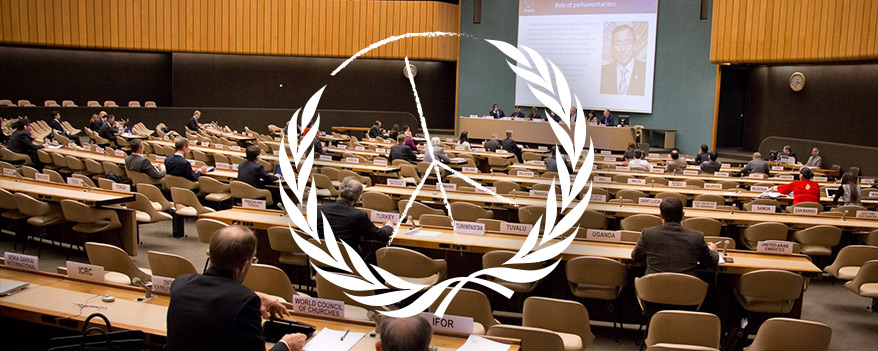Member countries of the United Nations will meet for a month this October at the UN General Assembly First Committee to discuss and adopt resolutions on disarmament and international security issues. One initiative they will likely discuss is the proposal to establish a UN Open Ended Working Group (OEWG) to take forward multilateral nuclear disarmament negotiations.
The proposal for such an initiative was discussed – and generally agreed upon – during the 2015 NPT Review Conference (see Final Draft Document of the 2015 NPT Review Conference page 20, item 154/19). It has also been supported by the Parliamentary Assembly of the Organisation for Security and Cooperation in Europe – a body representing the 57 parliaments of OSCE member countries – and by the Inter Parliamentary Union which represents over 160 parliaments.
The proposal follows up from an OEWG on nuclear disarmament that was established by the UN General Assembly in 2012 and ran for three working sessions (15 full days) in 2013.
UNFOLD ZERO supports the re-establishment of an OEWG and answers some of the questions about this proposal.
1. Is an OEWG just another talk-shop with no action?
No. The establishment by the UN of Open Ended Working Groups on specific issues is a fairly common practice in order to develop a legal instrument or instruments to address the issue concerned. Some OEWGs are given a direct mandate to negotiate a legal instrument. Others are given a pre-negotiation mandate, i.e. to explore and develop the elements and options for a legal instrument in order to pave the way for actual negotiations. In either case, the object is not to establish a ‘talk-shop’ but to facilitate the achievement of an international instrument or instruments.
The OEWG established by the UN in 2008 to address the arms trade is a successful example of this. The UN resolution establishing the OEWG recognised that ‘in view of the complexity of the issues of conventional arms transfers, further consideration of efforts within the United Nations to address the international trade in conventional arms is required’ to achieve ‘a balance that will provide benefit to all, with the principles of the Charter of the United Nations at the centre of such efforts.’ The OEWG was tasked to ‘further consider those elements’ [required for control of the arms trade] ‘for their inclusion in an eventual legally binding treaty on the import, export and transfer of conventional arms.’
By 2009 the OEWG had built sufficient agreement on the general elements for a legal instrument that the UN General Assembly was able to establish a negotiating conference (UNGA Resolution 64/48). However, the UNGA recognised that additional work was required on the specific elements, and therefore tasked the OEWG to continue its work for two more years as a preparatory process for the Arms Trade Treaty negotiations. The process succeeded in the adoption of an Arms Trade Treaty in 2013 (UNGA Resolution 67/234B).
An OEWG on nuclear disarmament could follow a similar path of deliberations moving into negotiations on a legal instrument (or instruments) to be adopted by a UN-established negotiating conference.
2. Did the proposal for an OEWG come from the nuclear armed States and their allies with the aim to block real progress on nuclear disarmament?
No. The proposal for an OEWG in 2016 is a follow-on from the OEWG that was established in 2012 at the initiative of Austria, Mexico and Norway – the same three countries that hosted the International Conferences on the Humanitarian Impact of Nuclear Weapons. It was not a proposal of the nuclear armed States or their allies. Indeed, as the First Committee Monitor reported: “The main opposition came from four nuclear weapon states, France, Russia, the United Kingdom (UK), and the United States (US). France, the UK, and the US made a joint EOV in which they said they see “little value in this initiative to take forward multilateral nuclear disarmament negotiations outside of the established fora.” (‘Disarmament Machinery’ by Beatrice Fihn, First Committee Monitor, 12 November 2012 p4).
Non-nuclear countries at the 2015 NPT Review Conference joined in supporting the continuation of work by an OEWG, most notably Sweden, whose Foreign Minister, Margot Wallstrom, promoted the proposal publicly.
3. Does the OEWG have to work by consensus?
No. The Final Draft Document of the 2015 NPT Review Conference, in recommending the establishment of an OEWG, also recommended that the OEWG conduct its work on the basis of consensus. However, such a recommendation is to be expected from the NPT which generally operates by consensus. The UNGA does not follow suit. Many of its decisions are taken by vote. The UNGA has even adopted disarmament and non-proliferation treaties by a vote. The CTBT is one example. With respect to the proposal for an OEWG, the NPT final draft document recognised that it is up to the UN General Assembly to ‘determine the methods of work of its subsidiary bodies’.
Consensus procedures can be useful in order to develop disarmament measures that might be able to achieve universality. On the other hand, consensus procedures can also be used to block progress, as has happened in the Conference on Disarmament for the past 19 years. One option for the UNGA would be to establish an OEWG with the aim to ‘strive for consensus’, but not to be bound by consensus if it is not possible to achieve.
There are concerns that one or more of the nuclear weapon states or their less progressive allies will ‘steal’ the initiative for the 70th UNGA to establish an OEWG, and promote a version whose rules of procedure require consensus. This is underscores the importance of prompt, independent action by like-minded states to pre-empt such a bad-faith maneuver.
4. Would the OEWG repeat the work done in 2013?
No. The OEWG met for 15 full working days in 2013 and helped outline the elements required for a legal framework to achieve a nuclear weapon-free world, and the various negotiating options to achieve this. These options include a stand-alone treaty (such as a nuclear weapons convention or ban treaty), a framework agreement followed by subsequent implementation agreements, or a hybrid approach (a collection of agreements). This work was very useful and was fed back into other UN and treaty bodies, most notably the 2015 NPT Review Conference. Several NPT working papers, and also the Draft Report of the Chair of the First Committee, referred to the options developed in OEWG in 2013. The OEWG in 2016 would not need to repeat this, but could use it as a starting point for further deliberations to pave the way for actual negotiations.
5. What specifically could the OEWG do in 2016?
Firstly, the OEWG could elaborate on the various disarmament measures in order to determine which ones could be achieved in the short term and in what manner negotiations could commence. The paper Effective Measures: Builders and Blockers by the International Law and Policy Institute (Norway) correctly points out that different measures can be negotiated by different groups, i.e. that not every measure needs to be negotiated by everyone.
Secondly, the OEWG could serve as a preparatory process for the High Level Conference on Nuclear Disarmament that the UN General Assembly has decided will be held no later than 2018. The Conference should aim to adopt one or more nuclear disarmament measures. The OEWG in 2016 could identify which measures would be possible to be adopted in 2018. The OEWG in 2017 could be given the mandate to negotiate these measures. Possibilities could include a framework agreement, a ban treaty (adopted by non-nuclear States) or a universal treaty on the non-use of nuclear weapons.
Thirdly, the OEWG could establish a subsidiary body to outline the specific security roles and situations ascribed to nuclear deterrence, examine whether nuclear deterrence does play a role in these situations, and, if so, explore alternatives to nuclear deterrence to meet these security situations. This subsidiary work, informally proposed by New Zealand and the Netherlands during the 2013 OEWG, would help move the nuclear armed States and those under extended nuclear deterrence relationships to reduce or relinquish their reliance on nuclear deterrence and enter into negotiations to prohibit and verifiably eliminate nuclear weapons. It would be important for such a subsidiary body to work on the axiom (accepted premise) that nuclear weapons also create insecurity, pose risks of catastrophic consequences from their potential use, and that eliminating the reliance on nuclear deterrence is a security, legal and humanitarian imperative.
6. What can you do to support?
Call on your government to support a UN General Assembly resolution in 2015 reviving the OEWG. Suggest specific work for the OEWG as along the lines of our answer to question 5 above.
For additional background see OEWG: Re-open the door

